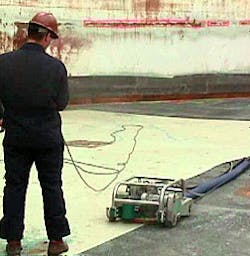The HydroCat is at work removing the fiber glass-bonded epoxy coating from the tank floor. The single operator uses a remote control to drive the HydroCat across the tank floor to remove the coating, which is white in the photo. The dark section in the photo reflects the clean, bare metal surface (Fig. 2).Clark Refining & Marketing Inc. saved about $75,000 by using a proprietary waterjet system vs. a gritblast system to remove an epoxy liner inside one of its refining tanks. The tank is located at Clark's Port Arthur, Tex., refinery.
Flow International Corp., Kent, Wash., manufactures the HydroCat equipment that was used to remove the coating.
Need for coatings removal
In 1998, Clark decided to inspect a fuels-storage tank that had been out of service for 6 years. The tank was originally built in 1954. It was a large tank with a diameter of 150 ft.To check the bottom of the tank for corrosion, the company needed to determine whether the tank floor needed to be replaced or repaired. Proper inspection procedures required a visual inspection, magnetic-imaging reading, and sonogramming. The floor of the tank, however, was covered with an epoxy that needed to be removed before accessing the real tank bottom.
Clark needed to remove up to 100 mils of fiber glass-bonded epoxy from the bottom of the tank as well as 2 ft-high epoxy from the sides of the tank-a total of 20,000 sq ft.
For similar projects in the past, Clark used gritblasting. The high cost of collecting and disposing of the resulting grit, however, caused Clark to look for another means of removing the epoxy.
After gritblasting, the spent grit must be transported out of the tank and loaded into trucks. For a tank of this size, about 20 rolloff boxes would be required to hold the spent abrasive. Disposal costs were $40/ton, which did not include transportation costs. And with tighter restrictions, future costs were expected to rise to approximately $850/rolloff box.
"We needed a more cost-effective method in which to remove the coating, and needed a better solution than sand gritblasting," said John Lewallen, Clark Refining's supervisor of tank repairs.
Gritblasting alternative
As an alternative to gritblasting, Clark chose to remove the epoxy by blasting it with water. With water, Clark was convinced it could save both time and money without sacrificing performance.Clark contracted with an operating company to remove the epoxy on the tank floor. The contractor used an automated waterjet-surface prep system from Flow International. Flow International's HydroCat system attaches itself to any vertical or horizontal surface with a vacuum.
With the HydroCat, a single operator can remove coatings at rates of up to 500 sq ft/hr, depending on the type of coating.
The HydroCat is powered by Flow International's Husky 40,000-psi pump and is equipped with a powerful FlowVac that serves two functions. First, FlowVac provides a powerful vacuum for secure attachment of the HydroCat to the work surface. Second, it transports all of the water and removed coating from the HydroCat robot to a filtration bag (Fig. 1) [6,897,080 bytes].
In the filtration bag, paint particles are filtered out and contained in easy haul-away bags. With the HydroCat, there is nothing in the air or on the ground to clean up, and filtered water can usually be disposed of into the sewer system.
Before starting the project, Clark cut off the top of the tank because it needed to be replaced anyway. A 10 ft x 12 ft access door was cut in the side of the tank to allow easy access inside the tank.
The tank was degassed and monitored daily to allow for safe operations inside of the tank.
Where the tank had detailed features, particularly along its edges, the Hydrocat could not be used. In these areas, Flow International's A-3000, an ergonomically designed surface-preparation hand tool, stripped the coatings 8-12 in. around these features and cleaned areas the HydroCat could not reach. To prevent light flash rusting, workers used the hand tools around the detail work prior to the HydroCat work. All edge work took about 9 hr to complete.
Next, the HydroCat removed coatings up to 2 ft high around the entire inside of the tank, and then removed the coating from the entire bottom of the tank. All removed coating was filtered into standard Flow International filter bags, which contained the removed coatings and filtered out the water. In all, ten bags were filled during the project.
The project was a huge success and took just 6 days to complete, at an average epoxy-removal rate of 465 sq ft/jetting hr. Had it used gritblasting, the project would have taken about 2 more weeks. Lewallen estimates that the company saved about $75,000 by using the waterjet system vs. a gritblasting system.
Clark also found numerous advantages to cleaning with the waterjets. They were able to save time because sonogramming could be conducted during waterjetting. Sonogramming was not allowed with gritblasting.
The surface was also cleaner than that resulting from gritblasting. The high-water pressure, about 40,000 psi, cleaned the smallest pits and did not pack them with sand. Because the waterjet system collects 100% of the water and removed coatings, workers were not exposed to abrasive blast dust or to the fiber glass epoxy coating in dust form.
Fatigue was also reduced since workers used hand-held tools for a shorter period of time than required for gritblasting-leaving much of the cleaning process to the HydroCat.
The waterjet system created a very clean surface with which inspection crews could work. This cleanliness improved inspection results. Fig. 2 shows the HydroCat running along the tank floor.
The HydroCat uncovered 51 holes in the bottom of the tank floor, which were not previously detected by other instruments. After using the HydroCat on the floor, in addition to having no rain, there was no rust for 28 days-until the first rain.
Copyright 1999 Oil & Gas Journal. All Rights Reserved.


